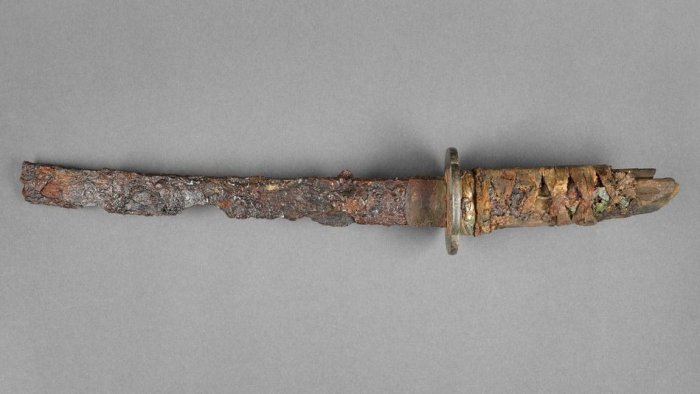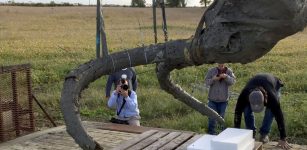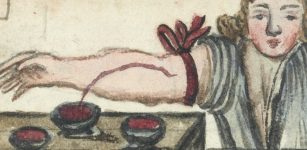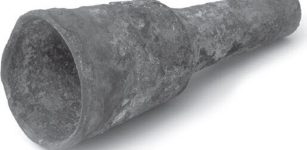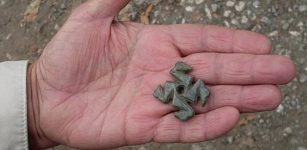Amazing Discovery Of A Wakizashi, Japanese Sword In Berlin-Mitte
Conny Waters – AncientPages.com – The archaeological excavations at Molkenmarkt in Berlin, Germany, have yielded a fascinating discovery. The Berlin State Office for Monument Preservation unearthed a short sword, initially misidentified as a parade saber, from a 20th-century cellar fill. Subsequent restoration work at the Museum of Prehistory and Early History of the Berlin State Museums revealed the artifact as a 17th-century Japanese Wakizashi.
Credit: Staatliche Museen zu Berlin, Museum für Vor- und Frühgeschichte / Anica Kelp
The excavation project also extended to Stralauer Strasse in Berlin-Mitte. Historical records show that until the mid-20th century, this street was narrower than it is today, with building facades reaching to the current curb. World War II damage and 1960s urban redesign efforts largely erased evidence of these original narrow structures. As expected, subterranean investigations in winter 2022 uncovered former residential and commercial building cellars beneath the street’s pavement.
The exposed cellar vaults contained debris from wartime activities. Several cellars yielded various artillery-related items such as bridles, stirrups, curbs, and harnesses, apparently discarded hastily towards the end of the conflict. A heavily corroded sword protruded from the rubble in the cellar vaults of former residential buildings at Stralauer Strasse 7-9. Initially thought to be a military parade weapon, this artifact was transferred to the Museum of Prehistory and Early History restoration workshop, which is responsible for conserving and storing all archaeological finds from Berlin.
Credit: Staatliche Museen zu Berlin, Museum für Vor- und Frühgeschichte / Anica Kelp
During the restoration work, a remarkable discovery was made. The heavily corroded sword was an incomplete Japanese short sword, a Wakizashi. Heat had severely damaged one side of the handle, but wood, textile wrapping, and ray skin were still partially preserved. The restoration revealed a 1 cm wide oxidized handle ferrule depicting Daikoku, one of Japan’s seven gods of luck, identifiable by his hammer and rice sack. Uncovering also exposed melted decorations of chrysanthemum and waterline motifs on the guard. Experts dated the handle to the Edo period (17th to 19th century) based on these motifs and style.
Before restoration, X-rays were taken to locate any existing forge marks. While no blacksmith’s signature was found, the images revealed an unexpected detail: the blade had been shortened from its original length. The handle was likely a later addition, as evidenced by two holes in the tang for wooden pin attachments, though the current handle used only one. This suggests the shortened blade was repurposed as a shorter wakizashi, making it significantly older than the handle—possibly dating back to the 16th century.
Credit: Staatliche Museen zu Berlin, Museum für Vor- und Frühgeschichte / Anica Kelp
“This discovery once again reveals the surprising objects waiting to be unearthed in Berlin’s soil. Who could have imagined that when few European travelers visited the country during Japan’s isolation, such a long-used and richly decorated weapon would find its way to Berlin?” Matthias Wemhoff, State Archaeologist of Berlin and Director of the Museum of Prehistory and Early History of the Berlin State Museums, said in a press statement.
Why the Wakizashi, once reserved for dignitaries as a status symbol, was discovered in a filled basement of a Berlin residential and commercial building remains a mystery. Speculation suggests it might have been a gift from the Takenouchi Mission in 1862 or the Iwakura Mission eleven years later. These Japanese ambassadors visited Europe and the Western world to build relationships and gather impressions. The proximity of Molkenmarkt’s aristocratic palaces to Berlin Palace supports this theory. King Wilhelm I received the Takenouchi Mission embassy in the palace, and as Emperor, he welcomed the Iwakura Mission in 1873. However, the sword’s origin cannot be linked to the biographies of the then-homeowners on Stralauer Strasse at Molkenmarkt.
See also: More Archaeology News
This discovery of a Japanese short sword in central Berlin highlights the secrets still buried in the metropolis. It underscores the importance of meticulous processing of finds in the restoration workshops of the Museum of Prehistory and Early History.
Written by Conny Waters – MessageToEagle.com – AncientPages.com Staff Writer



